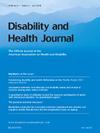覆盖范围之外的需求:残疾儿童或残疾父母之间的医疗保健不平等。
IF 3.7
2区 医学
Q1 HEALTH CARE SCIENCES & SERVICES
引用次数: 0
摘要
背景:残疾家庭聚集并不罕见。对残疾儿童的研究往往忽视了面临健康差距的一个特定群体:残疾父母的残疾儿童。目的:确定父母也有残疾的残疾儿童获得医疗保健的机会是否有限。方法:这是一项动态队列研究。本研究使用的数据为2017-2021年台湾残障登记和国民健康保险理赔数据。使用唯一的匿名识别号码将所有儿童与其亲生父亲和母亲进行匹配,以确定儿童及其父母的残疾状况以及儿童获得的医疗保健服务。结果:2021年共鉴定儿童及家长2 834 870对,其中残疾儿童53419对。其中,5188人的父母中至少有一人患有残疾。与父母均为残疾的儿童相比,父母均为残疾的儿童每年的门诊次数减少1.71次(P = 0.013)。与父母无残疾的儿童相比,父母有残疾的儿童出生时的普通门诊就诊次数分别减少了5.0和4.2次(P结论:即使在台湾这样的全民健康覆盖地区,父母也有残疾的残疾儿童也可能未充分利用医疗保健。标准的健康计划并不能消除这些儿童的医疗保健利用差距。本文章由计算机程序翻译,如有差异,请以英文原文为准。
Needs beyond coverage: Health care inequities among children with disabilities of parents with disabilities
Background
Family aggregation of disability is not uncommon. Research on children with disabilities has often overlooked a specific group facing health disparities: children with disabilities of parents with disabilities.
Objective
To determine whether children with disabilities, whose parents also have disabilities, experience limited access to health care.
Methods
This is a dynamic cohort study. The data used in this study were the 2017–2021 Taiwan's National Disability Registry and the National Health Insurance claims data. All children were matched to their biological fathers and mothers using a unique anonymous identification number to identify the disability status of the children and their parents and the receipt of health care services by the children.
Results
In 2021, a total of 2 834 870 pairs of children and parents were identified, of whom 53,419 were children with disabilities. Of these, 5188 had at least one parent with disabilities. Compared with children whose parents did not have disabilities, those whose parents both had disabilities had 1.71 fewer outpatient visits per year (P = .013). Compared with children whose parents had no disabilities, those whose parents had disabilities had 5.0 and 4.2 fewer general outpatient visits at birth (P < .001) and at the age of 2 years (P < .001), respectively. The magnitude of this effect decreased as the children's age increased.
Conclusions
Children with disabilities whose parents also have disabilities may underutilize health care even in settings such as Taiwan, where universal health coverage is available. Standard health programs do not eliminate health care utilization disparities for such children.
求助全文
通过发布文献求助,成功后即可免费获取论文全文。
去求助
来源期刊

Disability and Health Journal
HEALTH CARE SCIENCES & SERVICES-PUBLIC, ENVIRONMENTAL & OCCUPATIONAL HEALTH
CiteScore
7.50
自引率
6.70%
发文量
134
审稿时长
34 days
期刊介绍:
Disability and Health Journal is a scientific, scholarly, and multidisciplinary journal for reporting original contributions that advance knowledge in disability and health. Topics may be related to global health, quality of life, and specific health conditions as they relate to disability. Such contributions include:
• Reports of empirical research on the characteristics of persons with disabilities, environment, health outcomes, and determinants of health
• Reports of empirical research on the Systematic or other evidence-based reviews and tightly conceived theoretical interpretations of research literature
• Reports of empirical research on the Evaluative research on new interventions, technologies, and programs
• Reports of empirical research on the Reports on issues or policies affecting the health and/or quality of life for persons with disabilities, using a scientific base.
 求助内容:
求助内容: 应助结果提醒方式:
应助结果提醒方式:


